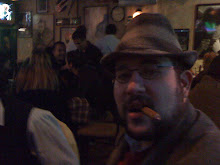Debido a que las grabaciones de los Beatles están sobredocumentadas y que la armonía de algunas canciones ha sido sujeta a análisis innecesariamente profusos, recientemente descubrí que es un peligro muy grave para cualquier procrastinador (no es necesario que le gusten los Beatles).
Primero, uno pone cualquier disco de los Beatles hasta que algo le llama la atención. Cualquier canción relativamente famosa de los Beatles puede terminar en horas de investigación. La información va desde los datos de siempre hasta la trivia más absurda. Una simple visita a Wikipedia puede ilustrar qué guitarra usó George Harrison, quién se la regaló, de qué canción de Bob Dylan tomó John Lennon una innovación estilística en la letra, qué hizo George Martin para que el piano sonara así. A partir de eso, uno puede empezar a profundizar sobre instrumentos, innovaciones técnicas de grabación, o elementos biográaficos de los Beatles.
El ejemplo más dramático, es el acorde de inicio de A Hard Day's Night. Doy por hecho que todos lo recuerdan, pero por si acaso aquí está:
(Por cierto que la letra va contra los principios fundamentales de la procrastinación, pues su esencia consiste en no seprar el trabajo y el descanso) En Wikipedia se pueden encontrar los siguientes datos de tan sólo dosegundos:
"A Hard Day's Night" is immediately identifiable before the vocals even begin, thanks to George Harrison's unmistakable Rickenbacker 360/12 12-string guitar's "mighty opening chord".[13][10] having what Ian MacDonald calls "a significance in Beatles lore matched only by the concluding E major of "A Day in the Life", the two opening and closing the group's middle period of peak creativity".[14] "That sound you just associate with those early 1960s Beatles records".[15] According to George Martin, "We knew it would open both the film and the soundtrack LP, so we wanted a particularly strong and effective beginning. The strident guitar chord was the perfect launch"
Analysis of the chord has been the subject of considerable debate,[16] with it being described as G7add9sus4,[17] G7sus4,[18][19] or G11sus4[13] and others below.
The exact chord is an Fadd9 confirmed by Harrison during an online chat on 15 February 2001:[20]
- Q: Mr Harrison, what is the opening chord you used for "A Hard Day's Night"?
- A: It is F with a G on top, but you'll have to ask Paul about the bass note to get the proper story.
According to Walter Everett, the opening chord has an introductory dominant function because McCartney plays D in the bass; Harrison and Martin play F A C G in twelve string guitar and piano, over the bass D, giving the chord a mixture-coloured neighbor, F; two diatonic neighbors, A and C; plus an anticipation of the tonic, G — the major subtonic as played on guitar being a borrowed chord commonly used by the Beatles, first in "P.S. I Love You" (see mode mixture), and later in "Every Little Thing", "Tomorrow Never Knows" and "Got to Get You into My Life" (in the latter two against a tonic pedal).[21]
In contrast, Alan W. Pollack interprets the chord as a surrogate dominant (surrogate V, the dominant preparing or leading to the tonic chord), in G major the dominant being D, with the G being an anticipation that resolves in the G major chord that opens the verse. He also suggests it is a mixture of d minor, F major, and G major (missing the B).[22] Tony Bacon calls it a Dm7sus4 (D F G A C), which is the dominant seventh (plus the fourth, G).[23] (For more information regarding chord functions see diatonic function.)
Everett points out that the chord relates to the Beatles' interest in pandiatonic harmony.[24]
Dominic Pedler has also provided an interpretation of the famous chord,[25] with the Beatles and George Martin playing the following:
- George Harrison: Fadd9 in 1st position on Rickenbacker 360/12 12-string electric guitar
- John Lennon: Fadd9 in 1st position on a Gibson J-160E 6-string acoustic guitar
- Paul McCartney: high D played on the D-string, 12th fret on Hofner 500/1 electric bass
- George Martin: D2-G2-D3 played on a Steinway Grand Piano
- Ringo Starr: Subtle snare drum and ride cymbal
This gives the notes: G-B-D-F-A-C (the B is a harmonic). One of the interesting things about this chord (as described by Pedler) is how McCartney's high bass note reverberates inside the soundbox of Lennon's acoustic guitar and begins to be picked up on Lennon's microphone or pickup during the sounding of the chord. This gives the chord its special "wavy" and unstable quality. Pedler describes the effect as a "virtual pull-off".[20]
Jason Brown, Professor for the Faculty of Computer Science at Dalhousie University in Halifax, Nova Scotia, Canada, whose research interests include graph theory, combinatorics, and combinatorial algorithms, announced in October 2004 that after six months of research he succeeded in analyzing the opening chord by de-composing the sound into original frequencies using a mathematical technique known as the Fourier transform.[26] According to Brown, the Rickenbacker guitar wasn't the only instrument used. "It wasn't just George Harrison playing it and it wasn't just the Beatles playing on it... There was a piano in the mix." Specifically, he claims that Harrison was playing the following notes on his 12 string guitar: a2, a3, d3, d4, g3, g4, c4, and another c4; McCartney played a d3 on his bass; producer George Martin was playing d3, f3, d5, g5, and e6 on the piano, while Lennon played a loud c5 on his six-string guitar.[27]
A repeated arpeggio outlining the notes of the opening chord ends the song in a circular fashion, fading out with the sound of helicopter blades. This provides "a sonic confirmation that the thirty-six hours we have just seen [in the movie] will go on and on and on"[1

3 comentarios:
ya me está llevando a límites horrible la maldita proc.
besos
Mano negra hubo ahí...
o mejor dicho ''garra''
Publicar un comentario